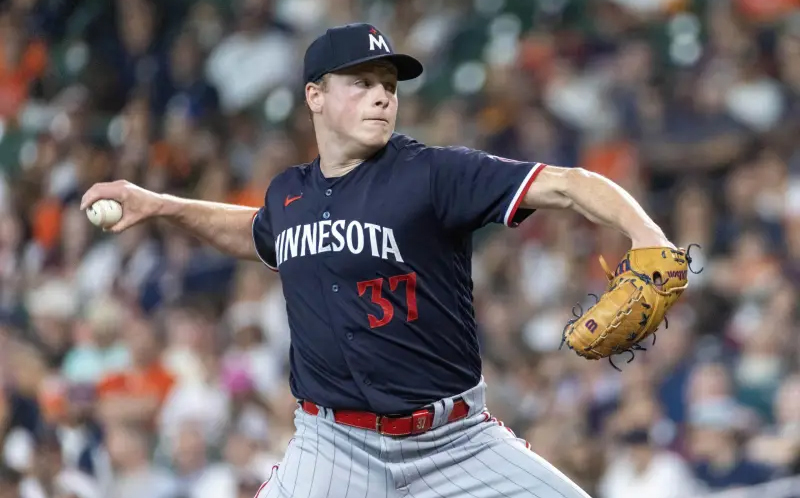The Minnesota Twins were expected to lose some key pieces after they announced that they would trim payroll. Sonny Gray found a new home in St. Louis, Kenta Maeda joined the division-rival Detroit Tigers, and the Cincinnati Reds signed Emilio Pagán.
The Twins were prepared to combat the trimmed payroll with many young and talented hitters, but filling out the pitching staff will be more difficult. They formulated a plan with Chris Paddack well before the eventual losses of Gray and Maeda. Bailey Ober developed into a solid third option with a refined north-south approach. With Pablo López and Joe Ryan the top two starters and Ober and Paddack behind them, there’s only one more open rotation spot.
Louie Varland is probably their best in-house option. His stellar fastball makes him an intriguing rotation option and a surefire quality reliever.
There isn’t one true best fastball shape. Some pitchers dominate with velocity and movement. Others excel with high spin efficiency and induced vertical break. A few manipulate the batter’s vision with low arm slots or release points to achieve flat approach angles. Varland checks every box.
Varland averaged 95.3 mph on his four-seamer last season. However, he touched 99.8 mph on Sept. 24 while working as a reliever.
Varland pairs a solid spin rate with the pitch’s plus velocity. He throws it with his hand a little “on the side” of the ball, which can dampen backspin and create less than ideal induced vertical break. Regardless, Varland can unlock 91.6% of his spin rate, leading to 16.3” of induced vertical break. The MLB average for righty starters is 15.7”.
Perhaps the best quality of Varland’s fastball is its flat Vertical Approach Angle (VAA). Varland releases the ball just 5.44 feet off the ground compared to the MLB average of 5.8 feet. Varland’s low release combined with decent spin equates to a great VAA.
Four-seamers of every VAA return more whiffs at the top of the zone. But the flatter the VAA, the better the pitch will perform. Varland’s four-seamer is 0.55 degrees flatter than the MLB average, which is a more intuitive 60 on the 20-80 baseball scouting scale.
The graph below, courtesy of Alex Chamberlain and FanGraphs, depicts the success of flatter four-seamers. It’s color-coded: Blue is the worst swinging strike rate, gray is average, and orange and red being are high swinging strike rates. The thick black lines represent the top and bottom of the strike zone, with each blue/gray/orange dot being a pitch location.
Based on this graph, a 0.55 Vertical Approach Angle Above Average (VAA AA) allows a pitcher to get whiffs at the top of the strike zone and above it. However, they still get a decent amount of whiffs in the heart of the zone.
Whiffs aren’t everything in pitching. A different graph below shows the four-seamer’s Deserved ERA (dERA) based on their VAA AA. dERA factors in strikeout and walk rates and expected weighted on-base average on contact (xwOBACON). Put differently, it’s a take on expected ERA.
Red refers to poor dERA, while green is good. As before, the thick black lines represent the top and bottom of the zone.
Varland’s 0.55 VAA AA again plays well at the top of the zone and just above it, where he can limit contact and rack up whiffs. He can still get swinging strikes lower in the zone. However, this graph shows the risk-reward nature of doing so; batters make better contact.
It is Varland’s four-seamer that gives him upside as a starter. He could lean into a north-south approach much like Ober and Ryan do and the way Paddack might.
If Varland can get slightly more “behind the ball” when he throws his four-seamer, it could play even better with that approach. He already has a good cutter to pair with it, which he used a lot like a hard slider.
Batters chased his cutter often (79th percentile O-Swing%) and missed often (84th percentile swinging strike rate).
Varland will need an improved slider and changeup to round out his arsenal and become a great starter. From an evaluation standpoint, there weren’t many opportunities to see either pitch. He threw his slider just 143 times and his changeup 123 times in his abbreviated 68 innings.
When Varland threw his changeup and slider, he may have been unlucky. Pitchers don’t have much control over their barrel rates, but Varland had barrel rates of 12.9% (9th percentile) and 21.7% (1st percentile) on his slider and changeup, respectively.
Varland would have benefitted from getting that pitch underneath the zone with two strikes. The pitch looked like a strike out of his hand, so Chapman was probably going to swing regardless of the pitch type.
If Varland can control his home run rate next season, whether from improved locations or better luck, he could be an excellent starter. However, the Twins may have him work out of the bullpen. Thanks to a stellar fastball, he profiles as a plus reliever.
Stuff is more important for relievers than it is for starters. In other words, pitchers with good stuff don’t need to have great command to succeed as a reliever.
Varland has good command, as evidenced by his 97th percentile Command+, which bodes well for his chances of being a full-time starter. But he has the necessary juice to thrive as a reliever. No matter his role in 2024, he could be an impact arm for the Twins.
Full article can be found at: https://zonecoverage.com/2023/mn-twins-news/louie-varland-developed-a-unique-fastball-that-baffles-pitchers/

